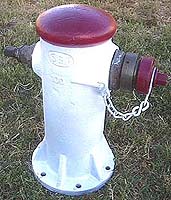Shand and Jurs produced hydrants from the late 1920s until World War II. They finished off their hydrants with a distinctive "mushroom head," many of which can still be seen in Berkeley and the East Bay. The Shand & Jurs Model 112 is believed to be the first 3-outlet wet barrel ever produced. S&J's model numbering system was simple. "1" stood for a smaller diameter (2½" or 3") outlet while a 2 stood for a larger diameter (4" or 4½") outlet. A zero represented "no outlet." Each model number contained 3 digits which described outlet sizes from top to bottom . A model 100 had a single small diameter outlet while a model 112 was a pumper hydrant with two small diameter outlets over a large "pumper" outlet. Anyone with additional information about Shand & Jurs' hydrant operations is encouraged to Email Us. |
| Click pictures for closeups |
| It appears that Shand and Jurs originated the "mushroom head" shape. They produced at least 5 models of mushroom head hydrants from the 1920s into the 40s. |
SINGLE OUTLET HYDRANTS
Model 100This version was S&J's shortest hydrant (19½" tall). It has a conventional "under the nozzle" chain attachment versus the wing gussets which appeared in the mid 1930s. We believe this hydrant to date back to 1929. |
0638 Willis Lamm Collection |
Model 100This hydrant came from a residential neighborhood in Oakland where it was installed around 1934 and remained in service until 2000. The nozzle collar reduces the hydrant from its original 3" size to the current 2½" standard. |
0606 Willis Lamm Collection |